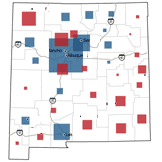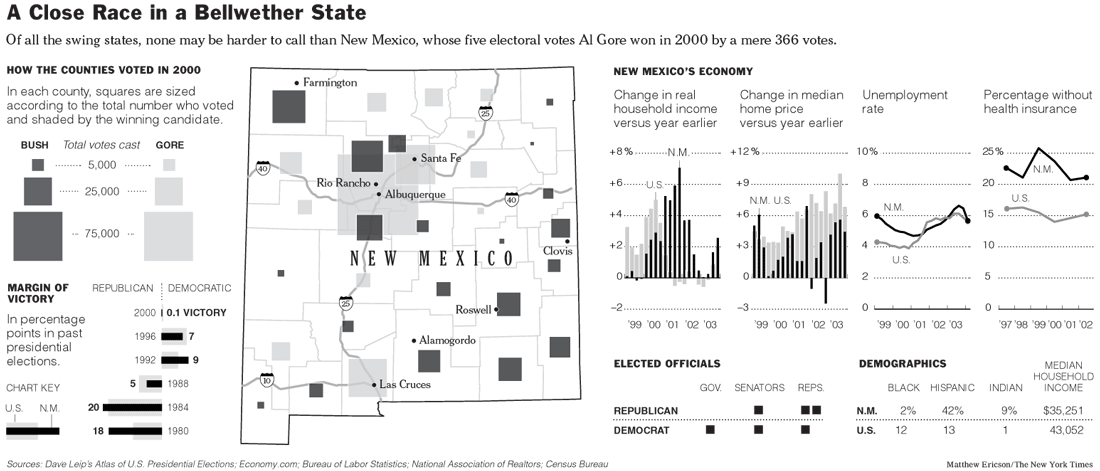
Published: July 20, 2004
Article originally published at http://nytimes.com/2004/07/20/politics/campaign/20state.html

 LBUQUERQUE - The crowd was cheering wildly as John Kerry, John Edwards and their spouses danced around one another on the open-air stage at the National Hispanic Cultural Center. Then Teresa Heinz Kerry took her turn at the microphone and said, "I am an immigrant, too," clearly making a bid for the many Hispanics in the audience.
LBUQUERQUE - The crowd was cheering wildly as John Kerry, John Edwards and their spouses danced around one another on the open-air stage at the National Hispanic Cultural Center. Then Teresa Heinz Kerry took her turn at the microphone and said, "I am an immigrant, too," clearly making a bid for the many Hispanics in the audience.
This time the applause was lukewarm and there was some head-shaking; many Hispanic families have been in New Mexico for generations and some take a dim view of immigrants.
"You know what the problem is with this state?" said Erlindo Castillo, a librarian in Santa Fe, in an interview afterward. "Too many Mexicans."
"They come here for the free services and to take our jobs, and then they send all the money back across the border," said Ms. Castillo, an American flag in one hand, a Kerry poster in the other.
With a population of just 1.8 million people spread across 121,666 square miles, New Mexico has the largest percentage of Hispanic residents - 42 percent - of any state. And at a time when both major political parties are struggling to attract Hispanics, who make up the country's fastest-growing voter demographic, New Mexico is prized as a laboratory for how to get that done.
Indeed, that experiment may well hold the key to this year's presidential election in this swing state.
So despite its mere five electoral votes, New Mexico has become a focus of both parties. President Bush and Senator Kerry have both been here several times this year, and Mr. Kerry and Mr. Edwards included the state in their first joint campaign swing.
The commercials on New Mexico television started almost as soon as the primaries wound down. Between March 13 and early June, the Bush campaign spent $883,538 on them, compared with $829,224 for the Kerry campaign and about a half-million dollars more for Democratic-leaning political groups.
Recently, both the Kerry and Bush campaigns announced a round of Spanish-language advertising to run in key states, including New Mexico.
But courting Hispanics is complicated and nuanced in a state where some families of Spanish heritage trace their lineage back to the 17th and 18 centuries and others are more recent arrivals from Mexico and other Latin American nations.
Issues like immigration or bilingual education, which candidates can use to appeal broadly to Hispanic voters in other states, do not always hit the mark so neatly here. Voters in New Mexico from old-line Hispanic families can share a cultural identification with newcomers, but have very different views on such touchstone issues.
The Hispanic vote here has gone solidly Democratic in recent decades, and is expected to do so again. But Republicans hope that a strategy of appealing to more conservative old-liners with a message of traditional family values and to bedrock Roman Catholics by stressing opposition to abortion will peel away enough votes to make the difference.
When he was governor in neighboring Texas, Mr. Bush embraced his state's growing Mexican-American population and ran better among Hispanics than Republicans usually do.
Republicans say their hope is not to win the Hispanic vote here, but to woo enough from the Democrats to supplement the party's white conservative base. In 2000, Al Gore carried New Mexico by a slim 366 votes, making it a blue island in a sea of Rocky Mountain red.
"I think about that number all the time," said Sheriff Darren White of Bernalillo County, who is running President Bush's campaign in the state's most populous county. "We don't intend to let it happen again."
Of course, many Hispanic voters here are firmly Democratic, like John P. Sanchez. Recently retired after 25 years as a law enforcement officer in the impoverished Rio Grande Valley, Mr. Sanchez had his medal-studded Vietnam Veterans cap pulled tight across his forehead as he watched Mr. Kerry address the crowd in Albuquerque.
"For me, this is about us having kids over there in Iraq, dying for no good reason," Mr. Sanchez said. "Republicans are crazy if they think they're going to get the Hispanic vote in New Mexico this year. They come here and say a couple of words of Spanish? What is that to me, you know what I mean?"
But there are pitfalls for the unwary, involving questions of identity and self-perception.
To many Hispanic families in New Mexico, especially in the northern mountains, the English speakers who trickled down the Santa Fe Trail in the 19th century were using the new highway. Their ancestors had come up the Camino Real, from Spanish colonies to the south.
"What makes us most unique is that we have this very old group of Hispanics whose ancestors came here starting in the 1600's," said F. Chris Garcia, formerly president of the University of New Mexico and now a political scientist there.
"The old-line families, even those who are still living in poverty, have very ambivalent views about these newcomers, and it shows in views about border issues and other things," Professor Garcia said.
Until the New Deal, the predominantly Roman Catholic, Hispanic community here voted solidly Republican. Since then, Hispanics have been steadfast Democrats, voting 62 percent for Mr. Gore in 2000. But Hispanic turnout, in all age groups, has consistently been significantly lower than turnout for whites, blunting the impact they might otherwise have.
For Republicans, the strategy here is to appeal to the conservatism of the Hispanics by speaking of traditional family values and abortion.
Nazarena Martinez and her husband own a 132-acre horse ranch called Cielito Lindo, or Beautiful Sky, on the eastern slopes of the Manzano Mountains. Her family has been in New Mexico for three centuries.
"My grandpa was a Republican, and when a lot of other families turned Democrat under Franklin Roosevelt, we stayed Republican," she said. "In their heart, I believe, the Spanish people in New Mexico share with Republicans the values of faith, family and property rights. We believe that you do what you want with your own land. And I think once this is made clear to people, there will be many more Hispanics for President Bush."
Elsewhere, one hears a different story. Christine Trujillo lives in Albuquerque but was born and raised in Taos County on land granted to her family in the late 1600's. "We're pretty typical," she said. "Land rich and dirt poor."
Now, she is the president of the New Mexico Federation of Education Employees, and a strong supporter of Mr. Kerry. "Only in the last 10 years have the party people begun to realize that we are a huge voting bloc," Ms. Trujillo said. "But the truth is that the Republican Party here has never had a place at the table for us. And now they want to attract us with single-issue appeals like abortion? That is such garbage."
New Mexico is the nation's fifth-largest state, in terms of area, but 36th by population. This translates into vast stretches of nothing, a high and dry landscape of parched scrublands and mesas covered with mesquite, sagebrush and ponderosa pine.
A third of the state's population is in Bernalillo County, home to the state's largest city, Albuquerque, and its nearest suburbs. And Albuquerque's political influence is even greater when fast-growing suburbs in neighboring counties are included.
Albuquerque's politics are fluid; the richer neighborhoods of the Northeast Heights tend to go Republican, while the working-class South Valley, predominantly Hispanic, goes heavily Democratic. In 2000, the metropolitan area went to Mr. Gore, but also elected a Republican to Congress, Heather A. Wilson.
The Democratic stronghold in New Mexico is in the north, along both sides of the Sangre de Cristo Mountains, from Santa Fe to Taos to the Colorado line, an area of liberal activism and vacation homes that one local historian called the "movie star and mysticism belt." But Democrats, buoyed by a growing Hispanic vote along the Mexican border, have also done well in recent elections in Dona Ana County, home to Las Cruces, the state's second-largest city.
For Republicans, the stronghold is in the east, the ranchlands called Little Texas whose landscape, population and voting patterns are barely distinguishable from those of neighboring West Texas. Republicans also see hope in growing suburban areas like Rio Rancho, northwest of Albuquerque, and more distant exurbs in adjacent Sandoval County.
The question is, who are the people who have moved into Rio Rancho and Las Cruces and Santa Fe since the last election? Are they the same conservative retirees from elsewhere in the Sun Belt who have been moving here for decades, or are they, as Democrats hope, part of a new wave of more liberal refugees from the Northeast and the West Coast?
At a recent Republican barbeque, Barbara Longeway, chairwoman of the Sandoval County Bush campaign, wore a T-shirt reading, "Friends Don't Let Friends Vote Democrat."
"I see a few bumper stickers around here for Kerry, but not too many," she said. "So I'm pretty confident."
The Democrats also feel confident. Recent voter registration data shows a rise in the proportion of Democrats since 2000, said Moses Mercado, Mr. Kerry's state campaign director, now 52 percent, up from 47 percent. And while an April poll by the American Research Group found Mr. Bush's and Mr. Kerry's popularity tied at 47 percent, a June poll taken by the group just prior to Mr. Kerry's selection of Mr. Edwards as his running mate saw some movement in Mr. Kerry's direction.
The key, leaders from both parties say, will be how well the Democrats turn out the Hispanic vote. "It's absolutely pivotal for us," said John Wertheim, the state Democratic chairman.

